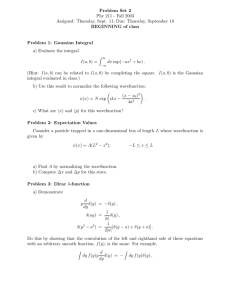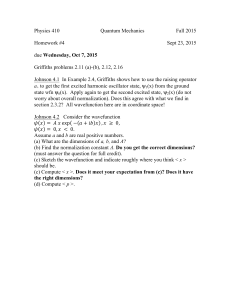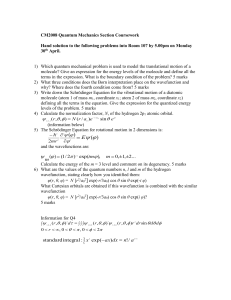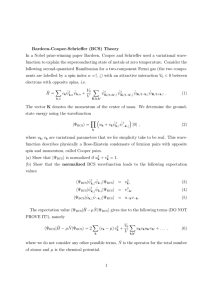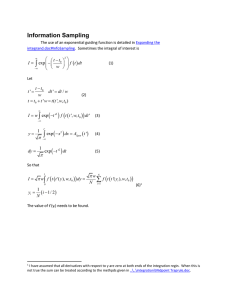Quantum Physics: Variational Method Solutions
advertisement
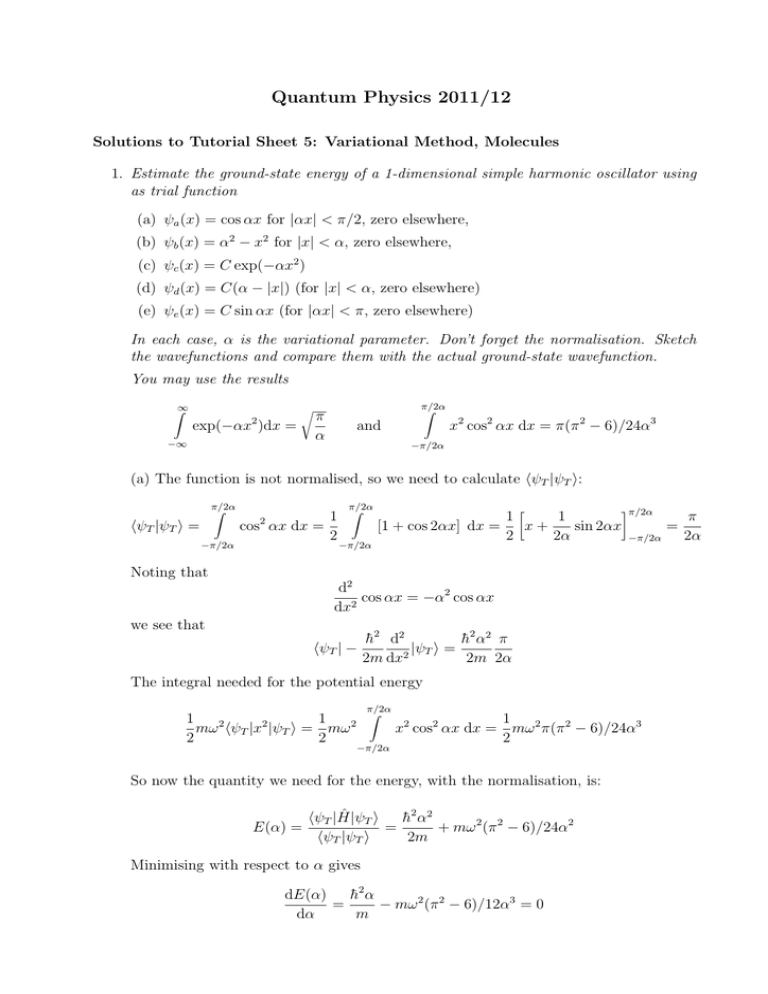
Quantum Physics 2011/12
Solutions to Tutorial Sheet 5: Variational Method, Molecules
1. Estimate the ground-state energy of a 1-dimensional simple harmonic oscillator using
as trial function
(a) ψa (x) = cos αx for |αx| < π/2, zero elsewhere,
(b) ψb (x) = α2 − x2 for |x| < α, zero elsewhere,
(c) ψc (x) = C exp(−αx2 )
(d) ψd (x) = C(α − |x|) (for |x| < α, zero elsewhere)
(e) ψe (x) = C sin αx (for |αx| < π, zero elsewhere)
In each case, α is the variational parameter. Don’t forget the normalisation. Sketch
the wavefunctions and compare them with the actual ground-state wavefunction.
You may use the results
r
Z∞
2
exp(−αx )dx =
−∞
π
α
π/2α
Z
x2 cos2 αx dx = π(π 2 − 6)/24α3
and
−π/2α
(a) The function is not normalised, so we need to calculate hψT |ψT i:
π/2α
Z
π/2α
·
¸π/2α
1 Z
1
1
π
cos αx dx =
[1 + cos 2αx] dx =
x+
sin 2αx
=
2
2
2α
2α
−π/2α
2
hψT |ψT i =
−π/2α
Noting that
we see that
−π/2α
d2
cos αx = −α2 cos αx
dx2
h̄2 d2
h̄2 α2 π
hψT | −
|ψT i =
2m dx2
2m 2α
The integral needed for the potential energy
π/2α
Z
1
1
1
2
2
2
mω hψT |x |ψT i = mω
x2 cos2 αx dx = mω 2 π(π 2 − 6)/24α3
2
2
2
−π/2α
So now the quantity we need for the energy, with the normalisation, is:
h̄2 α2
hψT |Ĥ|ψT i
=
+ mω 2 (π 2 − 6)/24α2
E(α) =
hψT |ψT i
2m
Minimising with respect to α gives
h̄2 α
dE(α)
=
− mω 2 (π 2 − 6)/12α3 = 0
dα
m
with solution
s
π 2 − 6 mω
12
h̄
Substituting this value into the expression for E gives as an upper bound on the
ground-state energy
s
π2 − 6
E(αmin ) =
h̄ω = 0.568h̄ω
12
2
αmin
=
(b) As before, we first calculate hψT |ψT i:
Zα
(α2 − x2 )2 dx =
hψT |ψT i =
−α
16 5
α
15
Noting that
d2 2
(α − x2 ) = −2
dx2
we see that the kinetic energy term is
α
h̄2 d2
h̄2 Z 2
4h̄2 α3
2
hψT | −
|ψ
i
=
(α
−
x
)
dx
=
T
2m dx2
m
3m
−α
whilst the potential energy term is
α
Z
1
8mω 2 α7
1
hψT | mω 2 x2 |ψT i = mω 2 x2 (a2 − x2 )2 dx =
2
2
105
−α
Combining these results gives
E(α) =
5 h̄2
1
+ mω 2 α2
2
4 mα
14
The minimisation condition is
dE(α)
5 h̄2
1
=−
+
mω 2 α = 0
dα
2 mα3 7
so that
s
35 h̄
2 mω
giving for the upper bound on the ground-state energy
2
αmin
=
5
E(αmin ) =
4
s
1
2
h̄ω +
35
14
s
35
h̄ω = 0.598h̄ω
2
(c) First we determine the normalisation constant, C:
Z∞
|C|
2
exp(−2αx2 ) dx = 1
−∞
Using the given Gaussian integral
r
hψT |ψT i = |C|
2
µ
π
=1
2α
2α
C=
π
⇒
¶1/4
To evaluate the kinetic energy term in the expectation value we can make use of the
trick described in lectures:
¯2
∞¯
∞
h̄2 d2
2h̄2 α2 |C|2 Z 2
h̄2 Z ¯¯ dψT ¯¯
hψT | −
|ψT i =
¯
¯ dx =
x exp(−2αx2 ) dx
¯ dx ¯
2m dx2
2m
m
−∞
−∞
∞
r
r
Z∞
d Z
d
π
π 1 −3/2
2
exp(−2αx ) dx = −2
x2 exp(−2αx2 ) dx =
=−
α
dα
dα 2α
2 2
−∞
−∞
Thus the desired integral is
Z∞
x2 exp(−2αx2 ) dx =
−∞
giving
1
4
r
π 1
·
2α α
h̄2 d2
h̄2 α
|ψ
i
=
T
2m dx2
2m
hψT | −
Likewise the potential energy term is
∞
1
|C|2 mω 2 Z 2
mω 2
2 2
hψT | mω x |ψT i =
x exp(−2αx2 ) dx =
2
2
8α
−∞
The minimisation condition is
dE(α)
h̄2
mω 2
=
−
=0
dα
2m
8α2
giving
αmin =
mω
2h̄
and hence a bound
h̄ω h̄ω
+
= 0.5 h̄ω
4
4
This is, of course, the exact result because our trial function is the correct ground-state
wavefunction for the 1-d oscillator.
E(αmin ) =
(d) First, calculate the normalization constant
C
2
Z α
−α
2
(α − |x|) = 2C
2
Z α
0
Which gives
q
C=
3/2α3
(α − x)2 = 1
Now, we calculate the potential energy
Z α
1
< V >= mω 2 C 2
x2 (α − |x|)2
2
−α
= mω 2 C 2 [α2 x3 /3 − 2αx4 /4 + x5 /5]α0
= mω 2 α2 /20
The kinetic energy comes from the discontinuity at x = 0. One way to treat this is to
redefine the function as having a form ψ = C(α0 − bx2 ) in a narrow region of half-width
δ about the origin, and then the real wavefunction ψT is the limit as δ → 0. To avoid
further discontiuities, we require the derivative to be continuous across the join. This
determines α0 and sets 2bδC = C The kinetic energy is then
< T >= −h̄2 C 2 /2m
Z δ
−δ
(α0 − bx2 )(−2b)dx
3h̄
[2α0 bx − 2b2 x3 /3]δ−δ
4mα2
= 3h̄2 /2mα3 (α0 bδ − b2 δ 3 /3)
=
As δ → 0, α0 → α whence < T >= 3h̄2 /2mα2 . Now we must minimise the total energy
with respect to α, i.e.
d
[3h̄2 /2mα2 + mω 2 α2 /20] = 0
dα
which gives:
α4 =
30h̄2
m2 ω 2
substituting for the energy:
q
q
U = h̄ω( 9/60 +
q
3/20) = h̄ω( 3/10) = 0.5477h̄ω
e) ψe (x) = C sin αx (for |αx| < π, zero elsewhere)
Normalisation hψT |ψT i:
π/α
Z
hψT |ψT i =
−π/α
So C =
q
π/α
·
¸π/α
1 Z
1
1
π
sin αx dx =
[1 − cos 2αx] dx =
x−
sin 2αx
=
2
2
2α
α
−π/α
2
−π/α
α
.
π
As in section (a), we notice that
d2
sin αx = −α2 sin αx
dx2
so that the kinetic energy
hT i = hψT | −
h̄2 α2
h̄2 d2
|ψ
i
=
T
2m dx2
2m
Now the potential energy is
π/α
Z
1
1
1
2
2
2π
mω hψT |x |ψT i = mω
x2 sin2 αx dx = mω 2 π(π 2 − 6)/24α3
2
2
α
2
−π/α
which we get by either integrating by parts, using maple or using the standard integral.
π/a
Z
x2 sin2 nax dx =
−π/a
π(2n2 π 2 − 3)
6n2 a3
Solving for the parameter α gives:
s
α2 =
2π 2 − 3
6
and substituting this back into the energy expression gives
s
E = hT i + hV i =
2π 2 − 3
h̄ω = 1.67h̄ω
6
By inspection, the overlap integral between (e) and the others is zero, because (e) is
an odd function and (a-d) are even functions. Since (a-d) are bounds for the ground
state, and (e) is orthogonal to the ground state, it must represent an estimate for the
first excited state. Moreover, since the exact ground state of an even potential is an
even function, (e) is orthogonal to the exact ground state. Thus it provides an upper
bound to the energy of the first excited state.
2. * A particle moves in one dimension in the potential
V (x) = ∞,
|x| > a,
V (x) = 0,
|x| ≤ a
Use a trial function of the form
(
ψT (x) =
(a2 − x2 )(1 + cx2 ), |x| ≤ a
0,
|x| > a
where c is a variational parameter, to obtain an upper bound on the ground-state energy.
You are advised to use Maple to solve the minimisation problem. How does your bound
compare with the exact ground-state energy?
Despite the number of integrals in these exercises, almost all modern quantum mechanics is done using computers. Once you have a maple script to solve the variational
problem, its simply a case of altering the potentials and trial wavefunction to use it
for other cases.
Firstly we compute the normalisation factor
Za
(a2 − x2 )2 (1 + cx2 )2 dx
hψT |ψT i =
−a
noting that the trial function vanishes for |x| > a. The Maple command is:
trial := (a^2-x^2)*(1+c*x^2);
i1 := int(trial*trial,x=-a..a);
Noting that in the potential well, there is no potential energy term, we just have to
calculate the kinetic energy term. We use the trick employed in the previous question:
¯2
a¯
h̄2 2
h̄2 Z ¯¯ dψT ¯¯
hψT | −
∇ |ψT i =
¯
¯ dx
2m
2m ¯ dx ¯
−a
We can evaluate the integral with Maple as follows:
d1 := diff(trial,x);
i2 := int(d1*d1,x=-a..a);
We then obtain
E(c) =
h̄2 2
∇ |ψT i
2m
hψT |ψT i
hψT | −
by taking the ratio of the previously evaluated integrals:
ratio := (hbar^2/(2*m)*i2/i1);
simplify(%);
to obtain
Ã
E(c) =
3h̄2
4ma2
!
11a4 c2 + 14a2 c + 35
a4 c2 + 6a2 c + 21
We then carry out the minimisation:
quad := diff(ratio,c);
solve(quad=0,c);
evalf(%);
giving two roots for c:
c(1) = −0.22075a−2 ,
c(2) = −7.31771a−2
Substituting these values in the expression for E(c)
sols := %;
bound1 := subs(c=sols[1],ratio);
bound2 := subs(c=sols[2],ratio);
gives
h̄2
h̄2
(2)
E(c ) = 12.7663 2
E(c ) = 1.23372 2 ,
ma
ma
(1)
so the minimum is reached for c = c , to be compared with the exact result for the
ground-state energy:
h̄2 π 2
h̄2
E1 =
=
1.23370
8ma2
ma2
So our variational estimate is an excellent approximation!
(1)
3. * Repeat the previous problem taking
(
ψT (x) =
(a2 − x2 )(x + cx3 ), |x| ≤ a
0,
|x| > a
as the trial function. Why does this give an upper bound for the first excited energy
level? Compare your variational result with the exact eigenvalue of the n = 2 level.
The trial function has odd parity and is therefore orthogonal to the exact ground-state
wavefunction, which has even parity. Thus it will give an upper bound on the energy
of the lowest odd-parity state, which is the first excited state of the symmetric square
well.
A similar exercise to the previous question, greatly simplified by using Maple:
trial := (a^2-x^2)*x*(1+c*x^2);
i1 := int(trial*trial,x=-a..a);
d1 := diff(trial,x);
i2 := int(d1*d1,x=-a..a);
ratio := (hbar^2/(2*m)*i2/i1);
simplify(%);
quad := diff(ratio,c);
solve(quad=0,{c});
evalf(%);
which gives
Ã
E(c) =
11h̄2
4ma2
!
23a4 c2 + 54a2 c + 63
5a4 c2 + 22a2 c + 33
and two roots for c:
c(1) = −.0516975a−2 ,
c(2) = −3.24574a−2
Substituting these values in E(c) gives:
h̄2
E(c ) = 4.9377 2 ,
ma
(1)
h̄2
E(c ) = 25.0623 2
ma
(2)
so the minimum is reached for c = c(1) , to be compared with the exact result for the
first excited-state energy:
h̄2 π 2
h̄2
E2 =
= 4.9348 2
2ma2
ma
4. A “1d atom” has ground state wavefunction u1 (x) = exp −α|x|. Consider a ring of
N such atoms, one centred on x = 0 separated by a distance d. Using the single site
wavefunctions u1j (x + jd) as LCAO basis functions, what are the LCAO wavefunctions
according to Bloch’s theorum in 1D?
If a Hamiltonian has a periodic potential, then the operator D̂f (x) = f (x − d) commutes with the Hamiltonian and eigenstates of the Hamiltonian must also be eigenstates of D̂. The wavefunction must be single valued, hence φ(x) = φ(x + N d), this
means that
φ(x) = exp(2πnix/N d)u(x)
where u(x) must have the same periodicity as the lattice. Assuming LCAO
u(x) =
N
X
u1 (x + jd)
j=1
Using the single site wavefunctions u1j (x + jd) as LCAO basis functions, write down
the ground state wavefunction for ring of N such atoms separated by a distance d, which
is an eigenstate of the displacement operator assuming that < u1 (x)|u1 (x + d) ><< 1.
The ground state wavefunction must obey rules for translational symmetry, and will
correspond to the least oscillatory wave, so it must be an eigenstate of the translation
operator defined by D̂f (x) = f (x − d). :
In matrix representation with the single-site basis, this operator is
0
0
0
0
...
1
1
0
0
0
...
0
0
1
0
0
...
0
0
0
1
0
...
0
...
...
...
...
...
...
Where the final line represents the periodic boundaries.
The least oscillatory eigenvector solution to this is:
Φ = (1, 1, 1, 1....) ≡
X
u1 (x − jd)
j
What is the normalisation for this wavefunction? This represents one (delocalised)
electron. The normalisation constant c is then given by
c2
X
hu1 (x − jd)|u1 (x − kd)i = 1
jk
Neglecting off diagonal terms hu1 (x − jd)|u100 (x − kd)i = δjk gives c =
q
1/N .
A computational physicist solves for this wavefunction using the variational method,
with a trial wavefunction ψT (r) and a set of variational parameters ck , k = 2π/N d
ψT (r) =
X
k
ck cos kx
Using your knowledge of the exact atomic solution u1 , what can you say about the
coefficients ck , and allowed values of k?
This trial wavefunction is simply a Fourier Series, with only even (cosine) terms. Thus
the coefficients are the Fourier coefficients of the expansion of the wavefunction. Since
the wavefunction is periodic with period d, we require the sum to be over k = 2πn/d
for integer n. Also, because u1 has discontinuous slope at x = 0, there is a delta
function in the kinetic energy, and many Fourier components are likely to be needed
to describe the wavefunction well.
Remark: This is convenient for computation, because the trial wavefunction can be
stored as an array of ck coefficients, and moreover the contribution to the kinetic energy
from each term is simply |ck |2 h̄2 k 2 /2m.
What would you get from a trial wavefunction of the form
ψT (x) =
X
ck sin kx
k
This is an odd function, orthogonal to the ground state and will give an upper bound
to the first excited state. In fact, it gives an odd function at each atomic site, so it
corresponds to the lowest state in the second band of states with n = 2: there are many
lower lying states in the u1 band.
5. Obtain a variational estimate of the ground-state energy of the hydrogen atom by taking
as trial function
ψT (r) = exp(−αr2 )
How does your result compare with the exact result?
Now
Z∞
Z
hψT |ψT i =
2
3
exp(−2αr ) d r = 4π
0
µ ¶3/2
1
π
r exp(−2αr ) dr = √
2 2 α
2
2
where we have used the Gaussian integral which appears in the last part of Question 1,
noting the different limits.
In 3D, the kinetic energy term can be evaluated by the integration by parts trick, which
is easier, but for interest here we will take the longer route. It is mathematically quite
interesting to show that the same result is obtained by both methods.
h̄2 2
h̄2 d2 2 d2
hψT | −
∇ |ψT i = hψT | −
r
|ψT i
2m
2mr2 dr dr
h̄2 Z −αr2
2
= −
e
(4α2 r2 − 6α)e−αr 4πr2 dr
2ms
3h̄2 2π
=
32m a
(1)
(2)
(3)
Where the given Gaussian integral could be evaluated by parametric differentiation or
by using Maple, to give
µ ¶3/2
hψT | −
h̄2 α 3
h̄2 2
π
√
∇ |ψT i =
2m
2m 2 2 α
The potential energy term involves a simple integral and is
∞
Z
e2
e2
e2 π
hψT | −
|ψT i = −
4π r exp(−2αr2 ) dr = −
(4π²0 )r
(4π²0 )
(4π²0 ) α
0
Thus we obtain
µ ¶1/2
hψT |Ĥ|ψT i
3h̄2 α
e2
2
= E(α) =
−
2
hψT |ψT i
2m
(4π²0 ) π
Minimising gives
µ ¶1/2
dE(α)
3h̄2
e2
2
=
−
dα
2m (4π²0 ) π
yielding
1/2
αmin =
µ ¶1/2
e2
2
(4π²0 ) π
α1/2
α−1/2 = 0
2m
3h̄2
and substituting back into the expression for E yields the upper bound on the energy:
8
E(αmin ) = −
3π
Ã
e2
(4π²0 )
!2
m
8
Ry = −11.54 eV
2 = −
3π
2h̄
How does your result compare with the exact result? Sketch the trial wavefunction and
the actual wavefunction on the same graph.
The exact answer is the Rydberg constant, -13.6eV. The wavefunction is an exponential
Ψexact ≡ exp(−ar).
2.5
The exponential (red, exact solution) and
gaussian (green, trial solution)
should each
R ∗
be normalised such that Ψ Ψ4πr2 dr = 1,
thus setting a=1 we get the graph opposite.
Note that although the trial wavefunction is
a pretty poor estimate of the exact one, yet
the energy is still only 15% wrong
2.0
1.5
1.0
0.5
0.0
0.0
0.5
1.0
1.5
x
2.0
2.5
3.0
